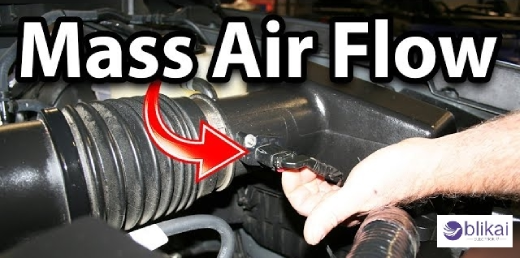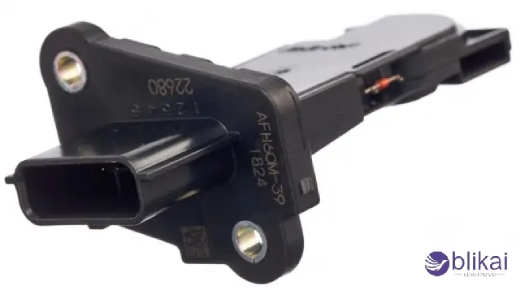What Is a Mass Air Flow Sensor
Sometimes, you may wonder why your car engine behaves sluggishly, especially when it suddenly loses fuel economy.
Understanding Mass Air Flow Sensors
A mass air flow sensor is one of the few critical components of modern vehicle engines. Its function is to measure large volumes of air entering the engine intake system. This crucial process passes much information to the engine control unit (ECU) for producing the right proportion of the fuel and air mix, which is required to ensure that the car runs fast and optimally at maximum fuel efficiency.

Key Components of MAF Sensor
- Housing: A plastic or metal casing that directs airflow through the sensor.
- Sensing element: Usually a hot wire or hot film that measures air mass.
- Electronic circuitry: These convert the readout from the sensing element into an electrical signal.
- Connector: Transmits data to the ECU.
How MAF Sensor Works in an Engine
The MAF sensor operates on the principle of heat transfer. As air flows over the heated sensing element cooling, the amount of current needed to keep the element at that temperature is directly proportional to the mass of air going through it. The MAF sensor sends this information to an engine control unit to fine-tune fuel injection and ignition timing for optimal combustion.
Importance in Vehicle Performance
Fuel efficiency benefits
Mass airflow sensors provide vital information to maximize fuel efficiency. By measuring the correct amount of air that enters the engine, the vehicle's computer can exact-tune fuel injections. With this fine-tuning, the proper air-fuel mixture is delivered to the engine, ensuring improved fuel economy while reducing waste.
Engine power optimization
In addition to controlling engine functions, the mass airflow (MAF) sensor provides power delivery to the engine, depending on driving scenarios. This means that the air-fuel mixture should vary between full-throttle acceleration from a standstill and full-throttle acceleration, thereby reducing the need for speed on the highway. Thus, the MAF sensor strikes a good balance between performance and flexibility.
Emission control advantages
The MAF sensor regulates the airflow and exhaust of the combustion chambers where combustion occurs. This enables efficient fuel burning and thus reduces emissions. It provides data in real-time to maintain the proper air-fuel ratio, whereby there is very little unburned fuel. This leads to reduced emissions from carbon monoxide and nitrogen oxides, among others.
Improved overall engine health
It guarantees that the engine valve opens to provide the proper air-fuel mixture to get maximum power at the combustion phase. This prolongs the life of critical components like spark plugs and catalytic converters and minimizes wear and tear on engine parts and carbon deposits. Hence, cars using a properly working MAF sensor will have a much-reduced chance of mechanical failure and require fewer repairs along their life span.
Types of Mass Air Flow Sensors
Hotwire MAF sensors
Hotwire MAF sensors are the most common type used in modern vehicles. They operate on the principle of heat transfer, using a heated wire or film exposed to the incoming air. As air flows over the wire, it cools it down. The sensor measures the current needed to maintain the wire temperature, which is directly proportional to the flow of air into the engine.
Cold wire MAF sensors
Cold wire MAF sensors, also known as cold film sensors, work similarly to hot wire sensors but without heating the sensing element. Instead, they measure the cooling effect of the airflow on an unheated wire or film. This design makes them less power-hungry and more durable than their hot wire counterparts.
Karman vortex MAF sensors
Karman vortex MAF sensors measure airflow differently. In this principle of vortex shedding, an obstruction in airflow creates a characteristic spin of vortices. The sensor counts these vortices to determine the air flow rate.
Common Issues and Symptoms
A. Dirty or contaminated sensor
Contamination is one of the significant problems that mass air flow (MAF) sensors have to contend with. Debris buildup, grease, and dirt may destroy the sensitive areas of the sensor, thus reducing its precision. The buildup could lead to false readings, causing discrepancies in the air-fuel mixture calculations executed by the engine control unit (ECU).
B. Electrical problems
Electrical issues can also plague MAF sensors. Wiring faults--which could be as simple as loose connections or damaged wires--will prevent communication between the sensor and the ECU. This, in turn, could result in incorrect signals being generated or a complete breakdown of the sensor due to voltage irregularities or short circuits.
C. Engine performance indicators
When an MAF sensor experiences problems, several engine performance issues may arise. These include rough idling, hesitation during acceleration, and rough or stalling engines. Drivers may also notice a lack of fuel economy or a power loss, which is more commonly felt during acceleration or while climbing hills.
D. Check engine light activation
Most visible among all the signs that say the MAF sensor isn't functioning correctly is the check engine light coming on. With modern vehicles, highly sophisticated diagnostics can tell when the MAF sensor provides inconsistent readings or is out of range, which is why the light will be on.

Maintenance and Care
Cleaning techniques
Regular cleaning of your mass airflow (MAF) sensor is crucial for maintaining optimal engine performance. To clean your MAF sensor, start by carefully removing it from the air intake system. Use a specialized MAF sensor cleaner spray designed to remove contaminants without damaging the sensitive components. Spray the cleaner onto the sensor's wire or film element, allowing it to air dry completely before reinstallation.
Replacement considerations
Cleaning can solve sensor issues for the MAF. However, in the case of severe damage or defective performance, replacement might be necessary. If cleaning does not solve a serious problem that impacts engine performance through rough idling or reduced fuel economy, you should consider replacing the MAF sensor. Yet, always pick a quality OEM-approved part for your replacements that adheres to your make and model's specifications for perfect compatibility and performance.
Preventive measures
You can lengthen the lifespan of your MAF sensor and avoid pre-time replacement through these prevention measures:
- Change the engine air filter regularly to minimize debris buildup on the air intake system.
- Avoid oiled air filters, as excess oil may choke the MAF sensor with impurities.
- Check the air intake system for leaks or damages that could let unfiltered air onto the sensor.
- Be cautious when working near the MAF sensor to prevent accidental damage.
Diagnosing MAF Sensor Problems
OBD-II scanner usage
An OBD-II scanner is an indispensable tool for diagnosing engine issues. It can be connected to the car's onboard diagnostic port, usually under the dashboard. Once it is connected, you should be able to seek error codes directly related to the MAF sensor, such as P0100 or P0101. These codes will provide some good clues about the exact problem affecting your MAF sensor.
Visual inspection tips
Conduct a visual inspection because it will likely point to some obvious problems with the MAF sensor. First, locate the sensor situated between the air filter and the throttle body. Look for any visible signs of damage, loose connections, and contaminants. Look for oil residue, dirt, or debris on the sensor wire or plate. Ensure that the sensor is tightly fit so there are no breaches, and make sure that electrical connections are tightly secured.
Performance testing methods
Performance tests are conducted to diagnose MAF sensor issues further. One method is the "tap test," where you gently tap the sensor while the engine is running. Variability in idle speed might suggest a defective sensor. The multimeter test can also be used to measure the sensor's voltage output; the results can then be compared with the manufacturer's specifications to ascertain proper sensor function. Moreover, the use of an advanced OBD-II scanner to read live data from the MAF sensor can reveal airflow values.
Conclusion
The engine's performance and economy and the emission of pollutants depend on the mass air flow sensor, a key device within the engine management system. From hotwire to Karman vortex sensors, each type offers unique advantages in measuring airflow. Recognizing common issues such as rough idling or decreased fuel economy can help you identify potential MAF sensor problems early on.
Related Articles
Differential Pressure Sensor: Working, Applications and Types
Smart Sensors: Introduction, Features and and Applications
What is a Capacitive Sensor: Types and Applications (2024)
Analog and Digital Sensors:Types and Applications
ACS712 Current Sensor:Principle,Features and Applications
What Steering Angle Sensor is :Principle,Features and Applications
How Do Motion Sensors Work? Types & Applications
Tilt Sensor Technology: Types, Advantages & Applications
What is Optical Sensor ? Overview and Applications
What are Wireless Sensor Networks : All Explained
Robot Sensor : Principle and Its Applications
IR Sensors: Schematic and Priciple Explained
Temperature Sensor Selection: Types & Design Techniques Analysis










